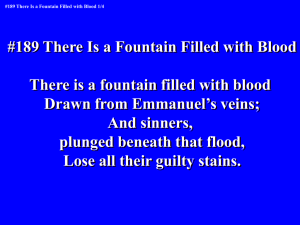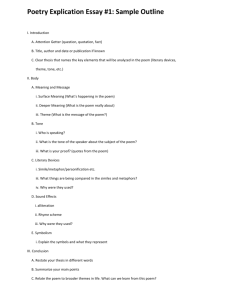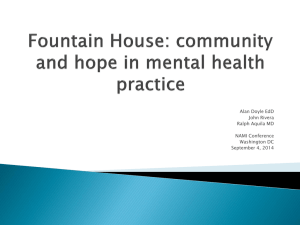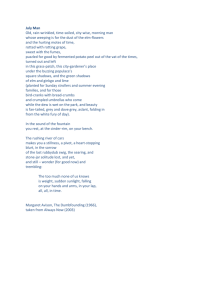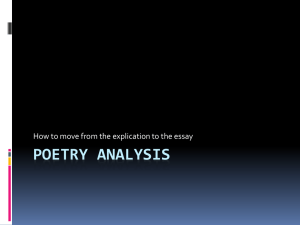File - Senior Shepard Academy
advertisement
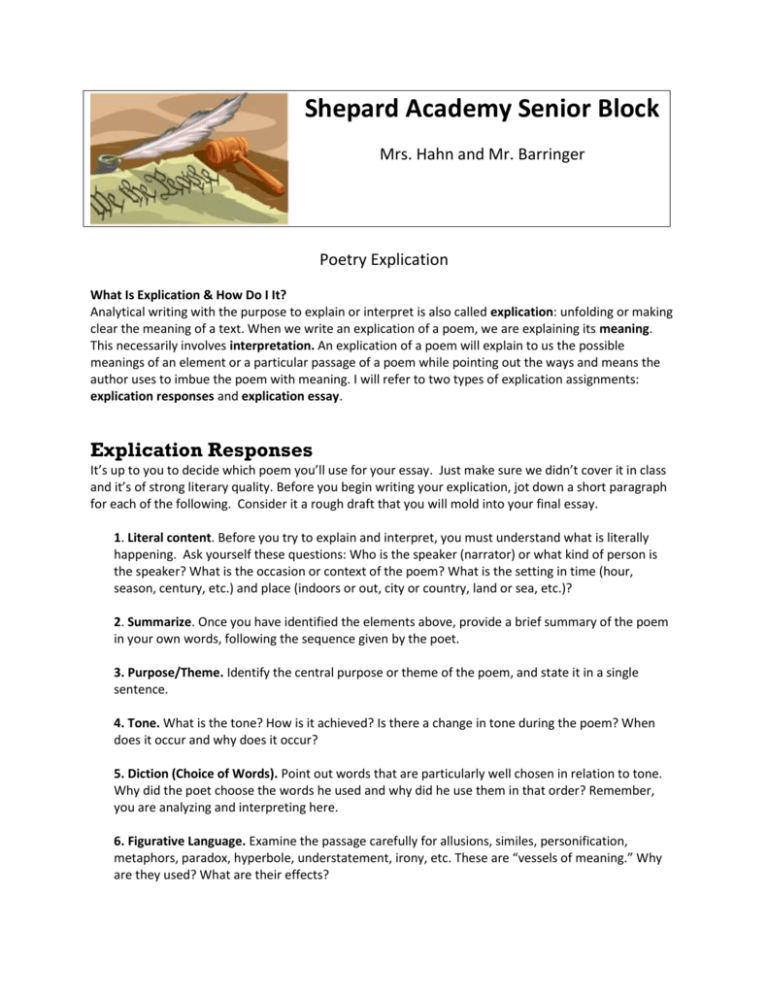
Shepard Academy Senior Block Mrs. Hahn and Mr. Barringer Poetry Explication What Is Explication & How Do I It? Analytical writing with the purpose to explain or interpret is also called explication: unfolding or making clear the meaning of a text. When we write an explication of a poem, we are explaining its meaning. This necessarily involves interpretation. An explication of a poem will explain to us the possible meanings of an element or a particular passage of a poem while pointing out the ways and means the author uses to imbue the poem with meaning. I will refer to two types of explication assignments: explication responses and explication essay. Explication Responses It’s up to you to decide which poem you’ll use for your essay. Just make sure we didn’t cover it in class and it’s of strong literary quality. Before you begin writing your explication, jot down a short paragraph for each of the following. Consider it a rough draft that you will mold into your final essay. 1. Literal content. Before you try to explain and interpret, you must understand what is literally happening. Ask yourself these questions: Who is the speaker (narrator) or what kind of person is the speaker? What is the occasion or context of the poem? What is the setting in time (hour, season, century, etc.) and place (indoors or out, city or country, land or sea, etc.)? 2. Summarize. Once you have identified the elements above, provide a brief summary of the poem in your own words, following the sequence given by the poet. 3. Purpose/Theme. Identify the central purpose or theme of the poem, and state it in a single sentence. 4. Tone. What is the tone? How is it achieved? Is there a change in tone during the poem? When does it occur and why does it occur? 5. Diction (Choice of Words). Point out words that are particularly well chosen in relation to tone. Why did the poet choose the words he used and why did he use them in that order? Remember, you are analyzing and interpreting here. 6. Figurative Language. Examine the passage carefully for allusions, similes, personification, metaphors, paradox, hyperbole, understatement, irony, etc. These are “vessels of meaning.” Why are they used? What are their effects? 7. Structure. Describe the form or pattern of the poem. Point out significant examples of sound repetition and explain their function. 8. Your thesis. The final step in pre-writing is penning the working thesis. The thesis should take the form of an assertion about the meaning and purpose of the poem. It must be something you can argue for and prove in your essay. Everything you say in support of the thesis must reference the text – by quotations, paraphrases, or summary. SAMPLE POETRY RESPONSES Because I Could Not Stop For Death by Emily Dickinson Because I could not stop for Death, He kindly stopped for me; The carriage held but just ourselves And Immortality. Or rather, he passed us; The dews grew quivering and chill, For only gossamer my gown, My tippet only tulle. We slowly drove, he knew no haste, And I had put away My labor, and my leisure too, For his civility. We paused before a house that seemed A swelling of the ground; The roof was scarcely visible, The cornice but a mound. We passed the school, where children strove At recess, in the ring; We passed the fields of gazing grain, We passed the setting sun. Since then 'tis centuries, and yet each Feels shorter than the day I first surmised the horses' heads Were toward eternity. 1. Literal content This poem reveals the narrator’s calm acceptance of death. She illustrates this point by comparing death to a casual carriage ride and personifying Death and Immortality as kind callers. The carriage ride is an analogy for her passing through the different stages of life: youth, middle age, and old age. 2. Summarize Because she was too involved with life to stop and accept death, Death kindly called on her in a carriage. The only other passenger in the carriage was Immortality. Slowly the carriage travels as she puts away her worldly cares for his civility. She passes through a schoolyard of children playing, a field of ripe grain, and the setting sun. She is dressed only in a thin gown of gossamer, and the air chills her. They stop before her grave, which she calls a house. She says that since then, the centuries have passed shorter than the day that she realized she was heading for an eternal life in the grave. 3. Purpose/Theme This poem is used to illustrate the narrator’s personal view of death. She does not see death as something to be feared; rather, she sees it as a calm, natural journey that everyone must take. The poem tells the reader not to fear death’s calling, for it is just another part of nature. 4. Tone 2 Poetry Recitation & Explication Mr. Rose The narrator’s tone is calm and casual; she is describing death as just an ordinary, natural occurrence. She achieves this theme through the analogy of a carriage ride, by personifying Death as a courtly caller, and by comparing her grave to a house. 5. Diction The narrator shows a friendly attitude towards death, using words such as “kindly” and “civility” when referring to it. This adds to the easygoing tone of the poem, and could help to relieve most readers’ fears about death. 6. Figurative Language Personification: Both death and immortality are personified as polite gentlemen callers. The author does this to illustrate her theme that death is not something to be feared, but rather a natural happening. The sun is also personified. Symbols: The tomb is used as a symbol for a house. This shows how death is the beginning of a new life. Death is compared to a carriage ride. In this way the author illustrates the theme, by comparing death to everyday occurrences. The children playing are used as a symbol for early life and innocence. The ripe grain is a symbol for middle age. The setting sun is a symbol for old age. These scenes show how one must travel through the different stages of life in order to reach death. Irony: Gossamer is the material that wedding dresses are made out of. It is ironic that she is wearing this material on the way to her death rather than to a wedding, which usually signifies life. 7. Structure The poem has six four-line stanzas. The rhyming is A-B-C-B. The poem is rhythmic and easy to read. The Explication Essay Before you write your explication essay, you will have already completed steps one through seven for your response, so that you have the “raw materials” to use in order to craft your essay. Of course, all of the elements of composition still apply. That means that explications need to be guided by a strong, clear thesis and supported with references to the text. The thesis should take the form of an assertion about the meaning and function of the poem which is your subject. It must be something which you can argue for and prove in your essay. Explications should be coherent and unified. Be sure to apply the knowledge you’ve learned through your readings in this unit thus far. Please also read through the sample explication response on Emily Dickinson’s “Because I Could Not Stop For Death” and the sample explication essay on “The Fountain” by Sara Teasdale. This gives you an excellent idea of what I am looking for with this assignment. SAMPLE EXPLICATION ESSAY John Q. Student AP Literature Mr. Barringer 25 December 0 B.C. The Fountain Fountain, fountain, what do you say Singing at night alone? "It is enough to rise and fall Here in my basin of stone." But are you content as you seem to be So near the freedom and rush of the sea? "I have listened all night to its laboring sound, It heaves and sags, as the moon runs round; Ocean and fountain, shadow and tree, Nothing escapes, nothing is free." -- Sara Teasdale Explication Essay Fountain, Fountain, What Do You Say? As a direct address to an inanimate object "The Fountain" presents three main conflicts concerning the appearance to the observer and the reality in the poem. First, since the speaker addresses an object usually considered voiceless, the reader may abandon his normal perception of the fountain and enter the poet's imaginative address. Secondly, the speaker not only addresses the fountain but asserts that it speaks and sings, personifying the object with vocal abilities. These acts imply that, not only can the fountain speak in a musical form, but the fountain also has the ability to present some particular meaning ("what do you say" (1)). Finally, the poet gives the fountain a voice to say that its perpetual motion (rising and falling) is "enough" to maintain its sense of existence. This final personification fully dramatizes the conflict between the fountain's appearance and the poem's statement of reality by giving the object intelligence and voice. The first strophe, four lines of alternating 4- and 3-foot lines, takes the form of a ballad stanza. In this way, the poem begins by suggesting that it will be story that will perhaps teach a certain lesson. The opening trochees and repetition stress the address to the fountain, and the iamb which ends line 1 and the trochee that begins line 2 stress the actions of the fountain itself. The response of the fountain illustrates its own rise and fall in the iambic line 3, and the rhyme of "alone" and "stone" emphasizes that the fountain is really a physical object, even though it can speak in this poem. The second strophe expands the conflicts as the speaker questions the fountain. The first couplet connects the rhyming words "be" and "sea" these connections stress the question, "Is the fountain content when it exists so close to a large, open body of water like the ocean?" The fountain responds to the tempting "rush of the sea" with much wisdom (6). The fountain's reply posits the sea as "laboring" versus the speaker's assertion of its freedom; the sea becomes characterized by heavily accented "heaves and sags" and not open rushing (7, 8). In this way, the fountain suggests that the sea's waters may be described in images of labor, work, and fatigue; governed by the moon, these waters are not free at all. The "as" of line 8 becomes a key word, illustrating that the sea's waters are not free but commanded by the moon, which is itself governed by gravity in its orbit around Earth. Since the moon, an object far away in the heavens, controls the ocean, the sea cannot be free as the speaker asserts. The poet reveals the fountain's intelligence in rhyming couplets which present closed-in, epigrammatic statements. These couplets draw attention to the contained nature of all objects in the poem, and they draw attention to the final line's lesson. This last line works on several levels to address the poem's conflicts. First, the line refers to the fountain itself; in this final rhymed couplet is the illustration of the water's perpetual motion in the fountain, its continually recycled movement rising and falling. Second, the line refers to the ocean; in this respect the water cannot escape its boundary or control its own motions. The ocean itself is trapped between landmasses and is controlled by a distant object's gravitational pull. Finally, the line addresses the speaker, leaving him/her with an overriding sense of fate and fallacy. The fallacy here is that the fountain presents this wisdom of reality to defy the speaker's original idea that the fountain and the ocean appear to be trapped and free. Also, the direct statement of the last line certainly addresses the human speaker as well as the human reader. This statement implies that we are all trapped or controlled by some remote object or entity. At the same time, the assertion that "Nothing escapes" reflects the limitations of life in the world and the death that no person can escape. Our own thoughts are restricted by our mortality as well as by our limits of relying on appearances. By personifying a voiceless object, the poem presents a different perception of reality, placing the reader in the same position of the speaker and inviting the reader to question the conflict between appearance and reality, between what we see and what we can know.


